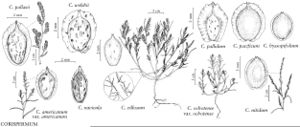Difference between revisions of "Corispermum welshii"
Novon 5: 348, fig. 1E. 1995.
imported>Volume Importer |
imported>Volume Importer |
||
| Line 47: | Line 47: | ||
|publication year=1995 | |publication year=1995 | ||
|special status= | |special status= | ||
| − | |source xml=https:// | + | |source xml=https://bitbucket.org/aafc-mbb/fna-data-curation/src/2e0870ddd59836b60bcf96646a41e87ea5a5943a/coarse_grained_fna_xml/V4/V4_609.xml |
|genus=Corispermum | |genus=Corispermum | ||
|species=Corispermum welshii | |species=Corispermum welshii | ||
Latest revision as of 21:59, 5 November 2020
Plant branched from base or nearly so, 10–35 cm, densely or sparsely covered with dendroid or stellate hairs (rarely with scattered papillae at margins of bracts). Leaf blades linear-lanceolate or linear, usually plane (or rarely slightly convolute or folded in dried plants), 1–6 × 0.2–0.5 cm. Inflorescences usually compact and dense, rarely ± lax, and condensed only at apex, ovoid, oblong-obovate, or oblong-clavate. Bracts ovate or ovate-lanceolate (rarely narrowly ovate-lanceolate), 1–3 × 0.3–0.8 cm. Perianth segment 1. Fruits yellowish brown, light brown, or brown, usually with reddish brown spots and whitish warts, strongly to slightly convex abaxially, usually concave adaxially, obovate or orbiculate-obovate, usually broadest slightly beyond middle (occasionally almost near middle), (3.3–)3.7–4.6 × (2.7–)3–3.6 mm, slightly shiny or dull; wing translucent, thin, (rarely translucent only at margin, thicker), (0.3–)0.4–0.6 mm wide, margins entire or irregularly minutely erose-denticulate, apex rounded, truncate, or indistinctly emarginate.
Phenology: Flowering late summer–fall.
Habitat: Sand dunes, sandy shores of creeks and rivers, dry valleys
Elevation: 1300-2200 m
Distribution

Ariz., N.Mex., Utah, Wyo.
Discussion
The names Corispermum hyssopifolium and C. villosum have been misapplied to C. welshii. Judging from its fruit morphology, C. welshii is closely related to C. americanum, especially to var. rydbergii. Forms intermediate between these taxa occasionally occur, especially in Utah. However, C. welshii differs from C. americanum in having shorter and thicker inflorescences and broader leaves and bracts. Forms similar to C. welshii occur also in other southwestern states, particularly in Colorado and western Texas. These plants are in need of additional study.
Selected References
None.
